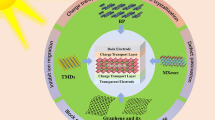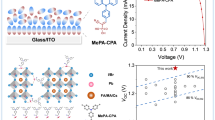Abstract
Si-based solar cells have dominated the entire photovoltaic market, but remain suffering from low power conversion efficiency (PCE), partly because of the poor utilization of ultraviolet (UV) light. Europium(III) (Eu3+) complexes with organic ligands are capable of converting UV light into strong visible light, which makes them ideal light converter to increase the efficiency of solar cells. However, the low stability of such complexes seriously hampers their practical applications. In this work, we report a highly stable and luminescent ethylene-vinyl acetate (EVA) copolymer film consisting of a Eu3+ complex as a down-shift material, Eu (ND)4CTAC (ND = 4-hydroxy-2-methyl-1,5-naphthyridine-3-carbonitrile, CTAC = hexadecyl trimethyl ammonium chloride), coating of which onto the surface of large area polycrystalline silicon solar cells (active area: 110 cm2) results in an increase of PCE from 15.06% to 15.57%. Remarkable stability of the luminescent film was also demonstrated under light-soaking test for 500 h, and no obvious luminescence degradation can be observed. The remarkable enhancement of the conversion efficiency by 0.51% absolute on such a large active area, together with the high stability of the luminescent film, demonstrates a prospect for the implementation of the films in photovoltaic industry.
摘要
硅基太阳能电池已经主导了整个光伏市场, 但是仍然面临着 光电转化效率低的问题, 其中部分原因是其对紫外线的利用率较 低. 稀土铕配合物能够将紫外光转化为可见光, 有望提高硅基太阳 能电池的光电转化效率. 然而, 这类配合物较低的稳定性限制了它 们的实际应用. 本文中, 我们制备了一种高度稳定的EVA/Eu(ND)4-CTAC发光薄膜, 将其覆盖在大尺寸的多晶硅太阳能电池表面 (110 cm2)可以使得光电转化效率从15.06%提高到15.57%. 在500 h 的加速老化实验中荧光性能几乎没有下降, 证明了发光薄膜的超 强稳定性. 在如此大的有效面积上, 发光薄膜使硅基太阳能电池的 转换效率提高0.51%的绝对值, 同时实现超高的稳定性, 说明该发 光膜在光伏工业上具有广阔的应用前景.
Similar content being viewed by others
References
Kabir E, Kumar P, Kumar S, et al. Solar energy: Potential and future prospects. Renew Sust Energ Rev, 2018, 82: 894–900
Lewis NS. Research opportunities to advance solar energy utilization. Science, 2016, 351: aad1920
Husain AAF, Hasan WZW, Shafie S, et al. A review of transparent solar photovoltaic technologies. Renew Sust Energ Rev, 2018, 94: 779–791
Parida B, Iniyan S, Goic R. A review of solar photovoltaic technologies. Renew Sust Energ Rev, 2011, 15: 1625–1636
Lian H, Hou Z, Shang M, et al. Rare earth ions doped phosphors for improving efficiencies of solar cells. Energy, 2013, 57: 270–283
Yu IS, Wu SC, Dumont L, et al. Monolithic crystalline silicon solar cells with SiN layers doped with Tb3+ and Yb3+ rare-earth ions. J Rare Earths, 2019, 37: 515–519
Fix T, Ferblantier G, Rinnert H, et al. Evaluation of the effective quantum efficiency of photon conversion layers placed on solar cells. Sol Energ Mater Sol Cells, 2015, 132: 191–195
Wang HQ, Batentschuk M, Osvet A, et al. Rare-earth ion doped up-conversion materials for photovoltaic applications. Adv Mater, 2011, 23: 2675–2680
Yao N, Huang J, Fu K, et al. Rare earth ion doped phosphors for dye-sensitized solar cells applications. RSC Adv, 2016, 17546–17559
Strümpel C, McCann M, Beaucarne G, et al. Modifying the solar spectrum to enhance silicon solar cell efficiency—An overview of available materials. Sol Energ Mater Sol Cells, 2007, 238–249
Huang X, Han S, Huang W, et al. Enhancing solar cell efficiency: the search for luminescent materials as spectral converters. Chem Soc Rev, 2013, 42: 173–201
Zhou D, Liu D, Pan G, et al. Cerium and ytterbium codoped halide perovskite quantum dots: a novel and efficient downconverter for improving the performance of silicon solar cells. Adv Mater, 2017, 29: 1704149
Xu W, Song H, Yan D, et al. YVO4:Eu3+, Bi3+ UV to visible conversion nano-films used for organic photovoltaic solar cells. J Mater Chem, 2011, 21: 12331–12336
Liu J, Wang K, Zheng W, et al. Improving spectral response of monocrystalline silicon photovoltaic modules using high efficient luminescent down-shifting Eu3+ complexes. Prog Photovolt-Res Appl, 2013, 21: 668–675
Katsagounos G, Stathatos E, Arabatzis NB, et al. Enhanced photon harvesting in silicon multicrystalline solar cells by new lanthanide complexes as light concentrators. J Lumin, 2011, 131: 1776–1781
Chen P, Shi J, Zhang Y, et al. EVA film doped with β-diketones macromolecular lanthanide complexes: Preparation, characterization and application. Eur Polym J, 2014, 58: 191–200
Le Donne A, Acciarri M, Narducci D, et al. Encapsulating Eu3+ complex doped layers to improve Si-based solar cell efficiency. Prog Photovolt-Res Appl, 2010, 17: 519–525
González-Pérez S, Sanchiz J, Rodríguez VD, et al. Highly luminescent film as enhancer of photovoltaic devices. J Lumin, 2018, 148–155
Li H, Li P. Luminescent materials of lanthanoid complexes hosted in zeolites. Chem Commun, 2018, 54: 13884–13893
Li Z, Wang G, Wang Y, et al. Reversible phase transition of robust luminescent hybrid hydrogels. Angew Chem Int Ed, 2018, 130: 2194–2198
Li Z, Hou Z, Fan H, et al. Organic-inorganic hierarchical self-assembly into robust luminescent supramolecular hydrogel. Adv Funct Mater, 2017, 27: 1604379
Wang Y, Li P, Wang S, et al. Recent progress in luminescent materials based on lanthanide complexes intercalated synthetic clays. J Rare Earths, 2019, 37: 451–467
Shahi PK, Singh AK, Singh SK, et al. Revelation of the technological versatility of the Eu(TTA)3 phen complex by demonstrating energy harvesting, ultraviolet light detection, temperature sensing, and laser applications. ACS Appl Mater Interfaces, 2015, 7: 18231–18239
Monzón-Hierro T, Sanchiz J, González-Pérez S, et al. A new cost-effective polymeric film containing an Eu(III) complex acting as UV protector and down-converter for Si-based solar cells and modules. Sol Energ Mater Sol Cells, 2015, 187–192
Zhang X, Wang T, Qin X, et al. Large-area flexible, transparent, and highly luminescent films containing lanthanide (III) complex-doped ionic liquids for efficiency enhancement of silicon-based heterojunction solar cell. Prog Photovolt Res Appl, 2017, 25: 1015–1021
Correia SFH, de Zea Bermudez V, Ribeiro SJL, et al. Luminescent solar concentrators: challenges for lanthanide-based organicinorganic hybrid materials. J Mater Chem A, 2014, 2: 5580–5596
Freitas VT, Fu L, Cojocariu AM, et al. Eu3+-based bridged silsesquioxanes for transparent luminescent solar concentrators. ACS Appl Mater Interfaces, 2015, 7: 8770–8778
Graffion J, Cattoën X, Wong Chi Man M, et al. Modulating the photoluminescence of bridged silsesquioxanes incorporating Eu3+-complexed N,N′-diureido-2,2′-bipyridine isomers: application for luminescent solar concentrators. Chem Mater, 2011, 23: 4773–4782
Nolasco MM, Vaz PM, Freitas VT, et al. Engineering highly efficient Eu(III)-based tri-ureasil hybrids toward luminescent solar concentrators. J Mater Chem A, 2013, 1: 7339–7350
Jiang L, Chen W, Zheng J, et al. Enhancing the photovoltaic performance of perovskite solar cells with a down-conversion Eucomplex. ACS Appl Mater Interfaces, 2017, 9: 26958–26964
Kettle J, Bristow N, Gethin DT, et al. Printable luminescent down shifter for enhancing efficiency and stability of organic photovoltaics. Sol Energ Mater Sol Cells, 2016, 144: 481–487
Tonezzer M, Maggioni G, Campagnaro A, et al. Luminescent solar concentrators employing new Eu(TTA)3phen-containing parylene films. Prog Photovolt-Res Appl, 2015, 23: 1037–1044
Fix T, Nonat A, Imbert D, et al. Enhancement of silicon solar cells by downshifting with Eu and Tb coordination complexes. Prog Photovolt-Res Appl, 2016, 24: 1251–1260
Zhang H, Song H, Dong B, et al. Electrospinning preparation and luminescence properties of europium complex/polymer composite fibers. J Phys Chem C, 2008, 112: 9155–9162
Wei H, Zhao Z, Wei C, et al. Antiphotobleaching: A type of structurally rigid chromophore ready for constructing highly luminescent and highly photostable europium complexes. Adv Funct Mater, 2016, 26: 2085–2096
Le Donne A, Dilda M, Crippa M, et al. Rare earth organic complexes as down-shifters to improve Si-based solar cell efficiency. Opt Mater, 2011, 33: 1012–1014
Bünzli JCG. On the design of highly luminescent lanthanide complexes. Coord Chem Rev, 2015, 19–47
Fix T, Rehspringer JL, Rinnert H, et al. Functionalization of a polymer encapsulant with photon conversion. Sol Energ Mater Sol Cells, 2015, 133: 87–91
Jeong HJ, Kim YC, Lee SK, et al. Enhanced spectral response of CIGS solar cells with anti-reflective subwavelength structures and quantum dots. Sol Energ Mater Sol Cells, 2019, 194: 177–183
Acknowledgements
This work was supported by the National Natural Science Foundation of China (21771050), the Natural Science Foundation of Hebei Province (B2016202147 and B2016202149), the Educational Committee of Hebei Province (LJRC021 and QN2015172), Hebei Province Natural Science Foundation (B2017202048), and Tianjin Natural Science Foundation (18JCYBJC17200).
Author information
Authors and Affiliations
Contributions
Wang Y and Li H designed the experiments; Wang Y performed the experiments; Zhang X, Yin J and Wen Y helped with the photovoltaic measurement. Wang Y wrote the paper with support from Li H. Gawryszewska-Wilczynsk P helped modify the grammar. All authors contributed to the general discussion.
Corresponding author
Additional information
Conflict of interest
The authors declare no conflict of interest.
Supplementary information Supporting data are available in the online version of the paper.
Huanrong Li received his PhD degree (2002) at Changchun Institute of Applied Chemistry, Chinese Academy of Sciences in the fields of functional materials based on lanthanide complexes. He spent 16 months at the Technical University of Munich under the Humboldt Fellowship. Afterwards, he initiated research on supramolecular chemistry of zeolite with Professor Gion Calzaferri at the University of Bern, Switzerland. In 2006, he was appointed as a full professor at the School of Chemical Engineering, Hebei University of Technology. His research interests and topics include luminescent host-guest functional materials and luminescent soft materials based on ionic liquids and lanthanides.
Yuan Wang received his Master’s degree from Hebei University of Technology, China, in 2017. Currently he is pursuing Doctor’s degree in Hebei University of Technology. His current research focuses on the application of rare earth luminescence materials.
Rights and permissions
About this article
Cite this article
Wang, Y., Gawryszewska-Wilczynsk, P., Zhang, X. et al. Photovoltaic efficiency enhancement of polycrystalline silicon solar cells by a highly stable luminescent film. Sci. China Mater. 63, 544–551 (2020). https://doi.org/10.1007/s40843-019-1246-5
Received:
Accepted:
Published:
Issue Date:
DOI: https://doi.org/10.1007/s40843-019-1246-5




